Meanwhile Karlsefin and his men did their best to put the place in a state of defence. A breastwork of large trees, which had been long ago thrown all round the hamlet, was repaired and strengthened before dark, and sentinels were posted around in all directions, so that when Biarne arrived, somewhat late at night, he was amused as well as gratified to find that unseen though well-known voices challenged him several times as he drew near home, and that, finally, a rude but effectual barrier stopped him altogether, until a friend from within conducted him to the proper entrance.
Thus the night passed away without anything transpiring, and at last the longed-for dawn appeared.
A GREAT BUT COMPARATIVELY Bloodless Fight, Which Ends Peculiarly, and with Singular Results.
––––––––

WHEN THE SUN ROSE ABOVE the trees next day, Karlsefin began to think that the natives had left the place, for there was no sign of them anywhere, and he was about to issue from behind his defences and go out to reconnoitre, when a man came running from the ship shouting “Skraelingers!”
It is probable that by that term he meant savages generally, because the men who had been seen bore very little resemblance to the hairy savages of Greenland. They were taller, though not stouter, and clothed in well-dressed skins of animals, with many bright colours about them. But whatever they were, the sensation they created among the Norsemen was considerable, for it was found, on going to the margin of the lake, that they were now approaching in canoes by water. This at once accounted for the delay in their appearance.
That their intentions were hostile was plain from the fact that the canoes came on abreast of each other in regular order, while the men shouted fiercely and brandished their weapons. There could not have been fewer than three or four hundred of them.
Karlsefin saw at once that his only chance of saving the ship was to go on board of it and fight on the water.
“Get on board all of you,” he cried to those who stood beside him. “Away, Biarne, Thorward, call in the outposts and have them on board without delay. Here, Swend, Heika, Tyrker, station the men as they arrive. Get up the war-screens round the sides of the ship; and, harkee, give orders that the men use their weapons as little as possible, and spare life. I shall want you on the poop, Hake. See that no one throws down the gangway or loosens the ropes till the order is given. I will see to the women.—Away!”
Each man ran with speed to obey, for the case was urgent.
Karlsefin found the women, with Olaf, assembled in the large house waiting for orders.
“Come,” he cried; “not a moment to be lost. Give me your hand, Gudrid.”
He seized it as he spoke, and hurried down to the ship, where the men were already trooping on board as fast as they could. The women were soon put under cover out of the reach of missiles, and in a few minutes more all were on board. Of course the cattle, and live stock generally, being scattered about the hamlet, were left to their fate. Then the ropes were cast loose, the gangway was thrown down, the ship was pushed out into the bay, and the anchor let go.
All this had barely been accomplished when the canoes came sweeping round the nearest point of land and made straight for the ship, with the foam curling at their bows.
Then Karlsefin’s voice rose loud and clear as he issued his final commands.
“My lads,” he cried, “remember my orders about using your weapons as little as possible. Be careful to throw only the smaller stones. Kill no one if you can avoid it, but give as many of them the toothache as you can. We must be friends with these people if we are to live in peace here, and that won’t be possible if we kill many of them.”
The men answered with a great shout, mingled with some laughter, which latter was such a strange sound to hear on the eve of an engagement, that the savages stopped short for a moment. But soon they came on again with redoubled impetuosity.
No sooner were they within range than the Norsemen rose up in a body and hurled a shower of stones at them. They were evidently not prepared for such artillery, for they again stepped short, but after a brief pause once more advanced. Three times did they receive a shower of stones before getting alongside. These hurt many, but disabled none, for, according to orders, no heavy stones were used. When within a few yards of the ship the canoes surrounded her and lay still while the savages began to discharge arrows in abundance. The Norsemen kept well behind the shields, which formed a screen round the ship, and replied with stones, only a few of the best marksmen using arrows, when they saw a chance to wound without killing any of the foe.
Karlsefin stood exposed on the high poop with Hake and Heika beside him. All three wore iron helmets, and the leader protected himself with his shield. Heika devoted his attention to warding off missiles from his brother, who, having to use his bow, could not manage a shield.
Presently the savages made a grand assault. But the moment they came to close quarters they found that they had to cope with a formidable foe, for the Norsemen, using only bludgeons, knocked them down whenever they came within reach, and one or two of the boldest among them who succeeded in clambering up the sides were seized by the legs and arms and hurled back into the lake as if they had been mere puppets.
Thus beaten off they continued the arrow shower, and some of the Norsemen were wounded.
All this time Karlsefin stood close to the helm, looking sharply about him, and whenever he saw a savage who was bolder and stouter than his fellows, he made Hake send an arrow through his right hand. In this way most of the best men among them were sent off howling with pain, and for the time disabled. Suddenly a very tall active savage succeeded in clambering up by the rudder unobserved, and leaping on the poop, stood behind Karlsefin with uplifted club. Karlsefin, without turning quite round, gave him a back-handed slap under the left ear and sent him flying overboard. He fell into a canoe in his descent and sank it.
At this juncture a number of the canoes were detached from the fight, and Karlsefin observed, with much anxiety, that the savages were going to ransack the houses.
“Would that I were on shore with twenty of my best men!” he said bitterly. “Send a shaft, Hake, at yonder fellow who leads. It is out of range, I fear, but — ha! well hit!” he exclaimed, on seeing an arrow from Hake’s prompt hand strike the man full in the back. The savage fell, and his comrades crowded round him.
By that time others of the canoes had put ashore, and their owners ran up to the crowd who surrounded the fallen leader.
At this moment an incident occurred which put a most unexpected termination to the fight.
For a considerable time Olaf’s huge pet, Blackie, had viewed the fight with calm indifference from the heart of a thicket close by, in which he chanced to be cooling himself at the time. Now, it happened that one of the many arrows which were discharged by the savages on the offshore side of the ship glanced from a neighbouring tree and hit the bull on the flank. Associating the pain resulting therefrom with the group of savages before him, Blackie at once elevated his tail, lowered his head, and, with a bellow that would have shamed a thousand trumpets, charged furiously down upon the foe.
Horror-struck is but a feeble word to indicate the feelings of that foe! Although, no doubt, some of them might have heard of, perhaps seen, the ponderous and comparatively quiet bison of the Western prairies, none of them had ever imagined anything so awful as a little black bull with tremendous horns, blood-red nostrils, flashing eyes, and cat-like activity. One awe-struck look they gave it, and then fled howling into the woods. The sounds were so startling that those of the enemy still round the ship were panic-stricken and made off by water as fast as their fellows had escaped by land, leaving the Norsemen victorious!
Читать дальше













